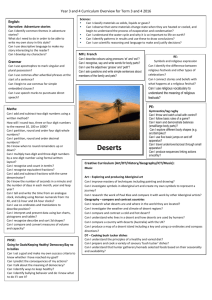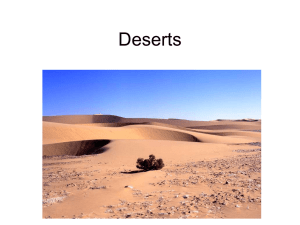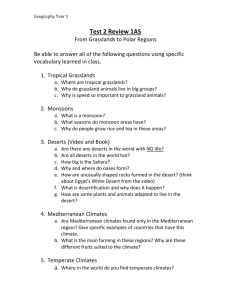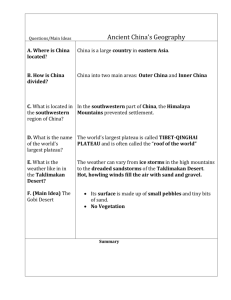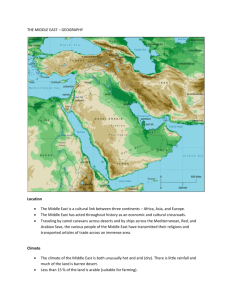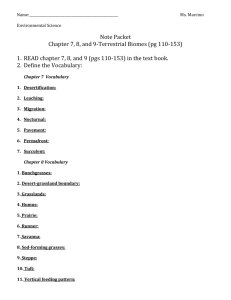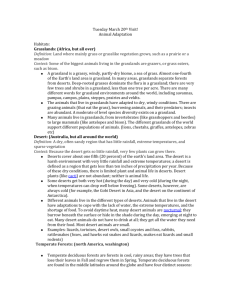CUSTOMER_CODE SMUDE DIVISION_CODE SMUDE
advertisement
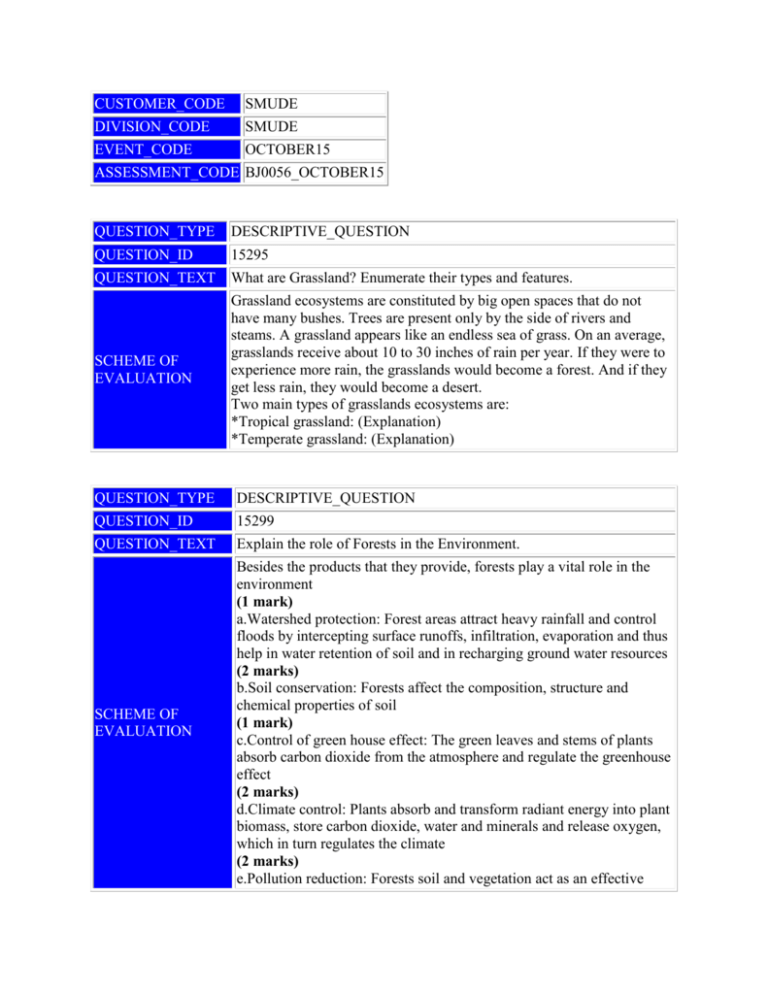
CUSTOMER_CODE SMUDE DIVISION_CODE SMUDE EVENT_CODE OCTOBER15 ASSESSMENT_CODE BJ0056_OCTOBER15 QUESTION_TYPE DESCRIPTIVE_QUESTION QUESTION_ID 15295 QUESTION_TEXT What are Grassland? Enumerate their types and features. SCHEME OF EVALUATION Grassland ecosystems are constituted by big open spaces that do not have many bushes. Trees are present only by the side of rivers and steams. A grassland appears like an endless sea of grass. On an average, grasslands receive about 10 to 30 inches of rain per year. If they were to experience more rain, the grasslands would become a forest. And if they get less rain, they would become a desert. Two main types of grasslands ecosystems are: *Tropical grassland: (Explanation) *Temperate grassland: (Explanation) QUESTION_TYPE DESCRIPTIVE_QUESTION QUESTION_ID 15299 QUESTION_TEXT Explain the role of Forests in the Environment. SCHEME OF EVALUATION Besides the products that they provide, forests play a vital role in the environment (1 mark) a.Watershed protection: Forest areas attract heavy rainfall and control floods by intercepting surface runoffs, infiltration, evaporation and thus help in water retention of soil and in recharging ground water resources (2 marks) b.Soil conservation: Forests affect the composition, structure and chemical properties of soil (1 mark) c.Control of green house effect: The green leaves and stems of plants absorb carbon dioxide from the atmosphere and regulate the greenhouse effect (2 marks) d.Climate control: Plants absorb and transform radiant energy into plant biomass, store carbon dioxide, water and minerals and release oxygen, which in turn regulates the climate (2 marks) e.Pollution reduction: Forests soil and vegetation act as an effective absorbent for a large number of pollutants and thus reduce pollutant in the environment (2 marks) QUESTION_TYPE DESCRIPTIVE_QUESTION QUESTION_ID 15300 QUESTION_TEXT Explain Food Chain. SCHEME OF EVALUATION The green plants convert solar energy to chemical energy with the help of inorganic substances such as water, carbon dioxide, as well as other nutrients and store it as food material. This is utilized by plants for their survival, which are then consumed by herbivores. The herbivores are consumed by carnivores and carnivores by top carnivores. Through this process, one form of life is supported by another. In other words, the transfer of food energy from the producers, through a series of organisms with repeated eating and being eaten, is known as food chain (7 marks) The arrangement in a food chain can be depicted as: Plant→ Herbivore→ Carnivore→ Top carnivore (3 marks) QUESTION_TYPE DESCRIPTIVE_QUESTION QUESTION_ID 73119 QUESTION_TEXT What is meant by desert ecosystem? Briefly explain its components. SCHEME OF EVALUATION Desserts are defined as regions wherein the average annual precipitation exceeds 20 inches per year and the amount of water lost through evapotranspiration is much more than the amount of water gained by precipitation. Thus desert ecosystems are highly sensitive and occur in regions that receive an annual rainfall of less than 25 cm. they occupy approximately 17 percent of all land on earth. On account of very high temperature, intense sunlight and water scarcity, desert ecosystems have poorly developed flora and fauna. Vegetation in deserts comprises primarily of bushes, shrubs, few grasses and very rarely, trees. Nature has designed the roots of these plants to be long and deep and their leaves and stems are modified to conserve water. Common desert plants are succulents like spiny leaved cacti. Deserts are of two types- hot deserts such as the sahara, the thar and the Mojave and cold deserts of which the best example is Antarctica. A major difference between hot and cold deserts is in the form of precipitation. There is snowfall in cold deserts and rainfall in hot deserts and rainfall in hot deserts. It may come as a surprise to you but even hot deserts have chilling temperatures at night. The species composition of such ecosystems is much more of us varied and typical due to extremes of both temperature and water availability. The different biotic components present in desert ecosystems are; 1. Producers; when it comes to desert vegetation, most of us only think of cactus.it may come as a surprise to you that are hundreds of varieties in desert ecosystems mainly consists of few shrubs and thromy trees. These plants have modified themselves to sustain in the desert environment. Some plants store water in specialized tissues while others have small leaves with hair like structures which reduce the rate of evaporation of moisture. The shrubs have widespread and branches root system with modified stems and branches. Trees such as kher, babul and lower plants like lichens and xerophytes mosses are found here. 2. Consumers; the desert and semi-arid regions have a number of highly specialized insects and reptiles that are adapted to survive under xeric conditions. The commonly found birds are partridge, quail and sand grouse. Common animals are wolves, desert cats and desert foxes. Camels feed on tender shoots of plants. The rodents, insects and reptiles which feed on desert plants are the primary consumers. At the top of the desert food chain are the apex predators in the form of birds and mammals. 3. Decomposers; due to poor vegetation, the amount of dead organic matter is scanty and hence, the same is true for decomposers. There are some fungi and bacteria that are found in deserts and most of them are thermopiles. QUESTION_TYPE DESCRIPTIVE_QUESTION QUESTION_ID 124532 QUESTION_TEXT Write down the value of biodiversity. 1. Consumptive use 2. Productive use 3. Social value SCHEME OF EVALUATION 4. Ethical value 5. Aesthetic value 6. Option value (Any five 2 X 5 = 10 marks) QUESTION_TYPE DESCRIPTIVE_QUESTION QUESTION_ID 124535 QUESTION_TEXT What are the main uses of forests? 1. Timber SCHEME OF EVALUATION 2. Fuel 3. Shelter 4. Food 5. Paper 6. Forest products (Any five 2 X 5 = 10 marks)
